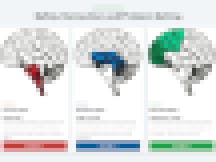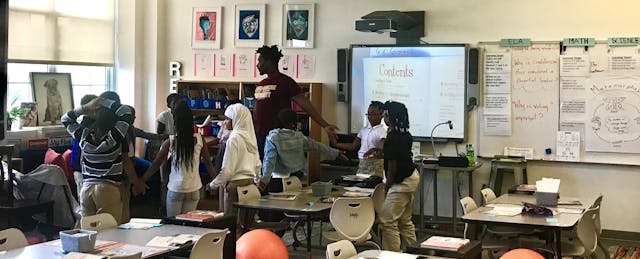WASHINGTON — When Stephanie Gunter accepted a second-grade teaching position at Langley Elementary, she was no novice. By that point, Gunter had been teaching in D.C. Public Schools for six years, and she felt she’d hit her stride in the classroom.
Then the new school year started.
From day one at Langley, a Title I school in northeast D.C., Gunter felt like she had no control over the students under her supervision. They were apathetic about their school work, disconnected from her and from one another and, not infrequently, combative.
Although her prior school was nearby and the student populations shared similar demographics, Langley was different. It felt unsafe. “It was really rough,” says Gunter. “I felt like a first-year teacher again.”
She recalls one student who threw a chair at her when she tried to gently reprimand him for his behavior, and another who started a physical fight over a crayon. “If it wasn’t the middle of the year, I would’ve left, and that’s honest,” she says.
The same year Gunter joined Langley, a new principal, Vanessa Drumm arrived. So did Monique Robinson, the school’s dean of students. They were aghast at what they found: “Our students didn't have a firm grasp on how to self-regulate, and I could tell that, previously, they were disciplined in a way that was very punitive, very militaristic, very rigid and strict,” Robinson explains.
Three years and a top-to-bottom transformation later, Langley is unrecognizable. New teachers hired at the elementary school this year would have a hard time believing that, just three years ago, the suspension rate was 66 percent and physical altercations were not uncommon among 7-, 8- and 9-year-olds.
Instead, new teachers see a school where “safe places” with cool colors and comfy couches are common and custom classroom songs are sung with gusto. New teachers join the staff knowing that, at Langley, they will learn and practice Conscious Discipline, a trauma-informed approach to social-emotional learning, and that the day doesn’t begin until students feel a sense of protection, trust and belonging in their classrooms.

Back in 2016, when Gunter, Robinson and Drumm arrived at the elementary school, the discipline philosophy “was very control-based: You move here, you sit here, you do that,” Robinson says. “And it didn't promote that level of self-awareness that we knew was a life skill that needed to be cultivated.”
The school leadership team started doing their homework. They looked into a variety of programs and approaches related to discipline, and more broadly, social-emotional learning—Positive Behavior Interventions and Supports (PBIS) and Second Steps among them—and came across Conscious Discipline, which uses brain research to predict and explain how a person may respond to a given scenario. It felt like a match right away.
Robinson, Gunter and a couple of other teachers soon went to a kickoff event to learn more about the research behind Conscious Discipline and how to implement it.
Gunter had been about ready to bolt. But sitting in that training in Florida, she remembers thinking, “I have to do something differently.” She decided to loop with her students—that is, move up to third grade with them and keep them all together in her class for another year. It had been a trying year, but she wanted to do right by her students and, along the way, find out if Conscious Discipline could actually work at Langley.
In fall 2017, after extensive reading, research and on-site training from Langley’s Conscious Discipline coach Nicole Mercer, a handful of teachers piloted the approach in their classrooms.
The first year was all about training and investing in the teachers, because they would be the ones responsible for whether the program clicked with students or not.
“We bring the information and the philosophy, and we teach the powers and skills of Conscious Discipline,” says Mercer, who is a certified instructor with the company, “but the work of changing what we call the ‘soil’ of the school—the transformational work—that falls on the teachers.”
The Conscious Discipline approach was created over 20 years ago by Dr. Becky Bailey, an educator and author with expertise in child and developmental psychology. The company, which has developed and refined the Conscious Discipline approach along with a set of strategies and resources, also provides trainings for educators and families to help them shift their understanding of behavior so they can create safe and positive environments for children.
The approach looks different in each school that practices it, but some core components stay the same. The Conscious Discipline Brain State Model—a framework for understanding the relationship between behavior and brain-body states—is a core element of implementation. Most schools also explore practices that help adults become more mindful, and teachers often use a set of seven skills to help them reframe their perceptions around behavior, transforming discipline issues into teachable moments.
It would be an oversimplification to say that learning some songs, attending a few trainings and talking about emotions more intentionally flipped the switch at Langley. But it would be accurate to say that even in its first year of implementation, when just a few teachers were trying out the approach, the school started to look and feel different.
In Gunter’s classroom, that change started with the teacher. During training, she had learned about “brain states.” When a child is in a survival state, their priority is being safe; when a child in an emotional state, their focus is on whether they are loved and cared for. Only when safety and belonging are accounted for can children move into their executive states, where they are able to learn. Understanding this helped Gunter build stronger connections with her students.

This was the element of Conscious Discipline that really struck the team at Langley. “Where you are in terms of your brain state … really dictates how you respond and with what feelings and how they transpire on your face and on your body,” Robinson explains. “When we were able to adapt that model to the needs of our school, it reshaped how we view behavior and it was an epiphany, like, ‘These kids need help.’”
Through Conscious Discipline, teachers have learned to ask, “Why?” every time they encounter poor behavior. Mercer says that being curious about it, rather than becoming irritated by it, allows teachers to “respond” instead of “react.” She adds that negative behaviors are usually a child’s way of communicating a need or crying out for help.
When the early adopters like Gunter started using this approach with their students, the results were immediate and dramatic, she says.
Gunter recalls one frank conversation she had with a student when they looped into third grade together: “I told him, ‘Last year, it wasn't safe for either one of us. We both made some choices that probably weren't the most helpful. I apologize. This year, let's try to work to make it better.’” She says being intentional about how she spoke to him and setting a new tone for their relationship brought about visible change.
That was a student who, in her first year, would start a fight on the spot over even the slightest disagreement, Gunter says. But in their second year together, she helped him to overcome his aggressive impulses by using language to express himself, such as “I don’t like it when …”
That same year, Gunter asked another student who was struggling with impulse control and aggression why he behaved that way. Just asking the simple question changed their dynamic completely. He eventually admitted to her that he was hungry, and together they found a way to get him food during school.
“We had some very powerful moments,” Gunter says.
The changes were so noticeable that several parents actually called the school and asked if everything was OK—they hadn’t gotten any calls about misbehavior lately and wanted to make sure the school still had their phone numbers. Other parents called to say they’d heard their kids talk about the breathing exercises and feelings-focused activities they were doing and wanted to know if they could get in on it, too. Langley has since held several parent workshops, led by Mercer, in an effort to make Conscious Discipline a community-wide practice.
Today, Conscious Discipline is used school-wide, and by all accounts, it has transformed Langley. From fall 2016 to fall 2018, suspension rates dropped from 66 percent to 24 percent and continue to trend downward. Attendance is up 2 percent—a metric administrators want to see increase more—and student performance on standardized tests has improved, which Robinson attributes to students being in a better state of mind to learn. The school has even hired additional staff to teach two newly added kindergarten and second grade classes, because enrollment is up this year. The spike, Robinson says, is due to Langley’s improved reputation.

On a recent morning in late September, a room full of kindergarteners looks up at their teacher, Heather Murphy, as she talks to them about their feelings.

“What does it feel like when you’re scared?” Murphy asks the students. They answer: “coughing,” “stomach ache,” “bad.”
Later, when explaining the emotion of sadness, she asks, “When have you felt sad?” One child shares that he was sad when his mom went away on a business trip. Another says he’s presently sad because his family has recently relocated to Washington, D.C., from Washington state, and he doesn’t like it.

After the lesson, they break out of the circle and sit at tables. Each student draws a picture of a time they remember feeling sad. In a “safe place” in the corner, the kindergarteners can use prompts on the wall or stuffed-animal “feeling buddies” to articulate how they are feeling at any given time throughout the day.
With older kids, teachers adjust the curriculum and activities to be age-appropriate.

In Danielle Williams-Bile’s fifth grade classroom, most students would roll their eyes at the “feelings buddies,” but this year, she built an age-appropriate “safe place” and found that it works.
“The way you introduce it is the way they receive it,” she explains. “If you make it corny, it will be, but if you own it, they will, too.” After creating a safe place fit for fifth graders—complete with fidget spinners, stress balls and notebook paper—Williams-Bile encouraged her students to go there when they were mad or frustrated or just needed a breather. One particularly troubled student has taken to it well, she says. He often goes to the corner, writes out an explanation of what is bothering him and gives it to Williams-Bile to read later. “He now is able to get his words out [and] his whole demeanor has changed.”
The flexibility and adaptability of the program gives teachers autonomy in their classrooms and provides opportunities for them to get creative. Each class has its own name, too, to promote a sense of unity among the students in it; Big Al’s Allstars, Travel Buddies and Loving Lions are a few class names emblazoned on the hallway walls.
“That's what I think makes it unique here,” Robinson explains. “We've been able to make it our own and have fun with it in a way that increases the buy-in as well. It's been fun to see, really.”


